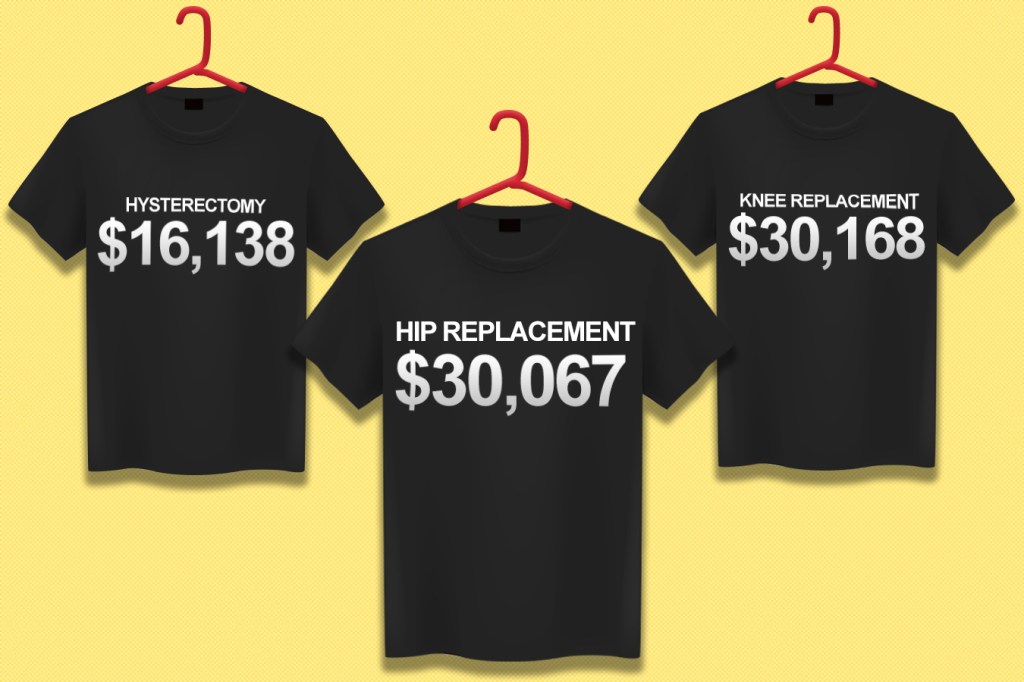If only patients knew how expensive medical procedures are and how wildly prices vary by hospital, they could be smart shoppers and lower the cost of health care for everybody.
At least that’s what policy experts and health insurers keep saying as they promote “consumer-directed” health care and cost-comparison websites.
None of it has had much effect. Now, exasperated Maryland officials are presenting hospital cost information in a way they believe Americans might understand: on a T-shirt.
“We tried to focus it on a level most consumers are at,” said Ben Steffen, executive director of the Maryland Health Care Commission, which created the campaign. “It is an opportunity to wear a billboard in certain public settings” to get people to ask questions, he said.
You can get a black shirt that says “HIP REPLACEMENT $30,067” in big type from the commission’s WearTheCost.org website. Or one that says “HYSTERECTOMY $16,138.” Other shirts feature prices for a knee replacement or baby delivery.
“I sent an email to all my colleagues in the health-policy wonk world and said, ‘I just got your holiday gift,’” said Dr. Ateev Mehrotra, a Harvard Medical School professor who has studied medical price transparency and patient responses.
Social media for the campaign points people to the WearTheCost.org website, which shows huge differences in what the same procedures cost at different Maryland hospitals.
The hysterectomy expense of $16,138 on the T-shirt is just an average. In recent years, the operation cost as much as $20,635 at Johns Hopkins Hospital in Baltimore and as little as $12,798 at Anne Arundel Medical Center in Annapolis.
Hopkins was also the most expensive hospital in which to have a baby, at $14,578, compared with the average Maryland cost of $11,590.
“Our teams treat the most complex cases in the region,” making them more expensive, said Hopkins spokesman Ken Willis. Hopkins supports publishing data to help patients make informed decisions, he added, but he said the Wear the Cost site “does not yet achieve that goal.”
The website’s price quotes apply to commercial insurance rates and include hospital care as well as non-hospital spending, such as doctors’ fees and prescription drugs.
The reported expenses are adjusted so that “it would take account of differences in case severity,” Steffen said.
Hospital-to-hospital results vary sharply even under Maryland’s health care finance system, which regulates what hospitals are paid. One reason is that hospitals make money from their mistakes. Those with high rates of avoidable complications, such as infections or drug reactions, end up delivering more care, for which they charge.
Wear the Cost’s software tries to measure this, flagging avoidable problems and calculating the expense. Potentially avoidable complications added $2,271 to the cost of a hysterectomy at Johns Hopkins.
Such costs were even higher at Baltimore’s Saint Agnes Hospital, adding $5,481 to a hysterectomy’s total cost of $18,433. (The hospital did not respond to requests for comment.)
A $4 million federal grant financed the Wear the Cost campaign, which was led by the commission’s analysis director, Linda Bartnyska, who died of breast cancer in August.
Economists like to note that health care lacks many attributes needed for a minimally functioning market, including customers who understand the product and know what it costs.
The price transparency movement was supposed to help fix that. If patients give more business to lower-cost institutions with fewer complications, the thinking goes, hospitals will work harder to contain costs and improve outcomes, slowing the increase in insurance premiums and government health expenses.
“The hope is that, over time, consumers will come to expect that prices are available … and use them regularly in making decisions about where to get care,” said Sarah Litton of Altarum, a research and consulting firm that worked on the campaign with the Maryland commission.
But it’s an uphill fight. Nobody checks hospital prices when they have a heart attack or get in a car crash, so Wear the Cost, which has given away more T-shirts than it has sold, focuses on elective procedures that people can shop for in advance. Even these patients, though, tend to go to wherever doctors suggest. Since insurance usually pays everything for in-network hospitals once out-of-pocket spending limits are met, they have little incentive to shop around when considering pricey procedures. The patient’s portion is likely to be similar whether a joint replacement is $25,000 or $50,000.
Federal authorities recently required hospitals to start posting their charges online, but these bear little relationship to what most patients and their insurers pay.
Just 3 percent of adults under age 65 compared costs between medical providers before getting care, found a 2017 survey led by Mehrotra.
“To date, price transparency initiatives that have been rigorously assessed have had little to no impact on prices in the health care system,” Mehrotra said. “The reason so far is few people are using those websites.”
Still, maybe the point of programs like Wear the Cost “is to shame” expensive hospitals, to say, ‘What the heck is going on here?’” Mehrotra said. “’Why are you 50 percent more’” than the hospital across town?







